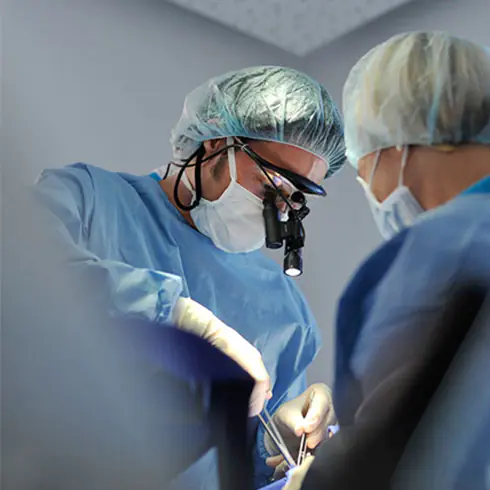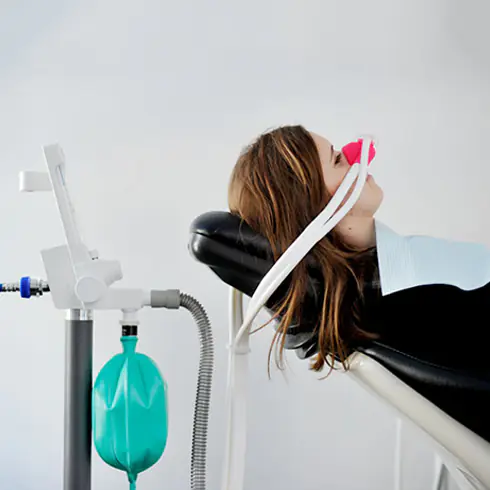
For patients who suffer from a more or less pronounced fear of going to the dentist, dental treatment is a stressful situation. In this case, treatment under local or general anaesthesia makes sense. In our surgery in Mainz, we use painless nitrous oxide sedation as an anaesthetic for those patients with anxiety issues.
Laughing gas is inhaled through a small nose mask and gives a calming and relaxed feeling. The sensation of pain is greatly reduced and the gag reflex is suppressed. Laughing gas only works as long as it is inhaled. Patients are conscious and fully responsive during the treatment. They are fully responsive again immediately after the procedure. Nitrous oxide sedation is a very safe method of anaesthesia, which is also very suitable for children.


For all procedures in which laughing gas sedation and the injection of a local anaesthetic are insufficient, we also offer treatments under general anaesthesia in our surgery in Mainz. In this case, the anaesthetic is administered by an experienced specialist in anaesthesia in accordance with the latest medical findings and the highest safety standards.
Nowadays, healthy patients are very unlikely to experience risks or allergic reactions during local anaesthesia or anaesthesia. This is due to the further development of new anaesthetics, which guarantee better tolerance for the patient, faster elimination from the organism and fewer side effects. The dentist controls the depth of anaesthesia during dental treatment and constantly monitors vital functions such as heartbeat, breathing and blood pressure so that there is no stress on the cardiovascular system. The duration of the anaesthesia can thus be extended to the desired treatment time without any problems.
Thanks to the use of modern medication, side effects such as nausea and dizziness, which were common in the past, are no longer a problem.
"You don't want your fear of the dentist to get in the way of your dental health. We provide a calm and stress-free atmosphere."
1. Short discussion with the dentist
Before your treatment, you will have the opportunity to ask any questions or concerns you may have about the procedure. We will also be happy to provide you with a detailed consultation on the subject of anaesthesia as well as further information on your individual options in advance. We support our patients suffering from dental anxiety with care and understanding.
2. Initiation of the procedure
At the beginning of the procedure, an anaesthetic is administered – in the case of our dental surgery in Mainz, nitrous oxide. The procedure starts with 100% oxygen and after a short time the anaesthetic is added until the sedative effect takes effect and no more pain is felt. Only then is the medical procedure continued.
3. Local anaesthetic
As soon as the sedation has taken effect and the sensation of pain has been reduced to a minimum, the local anaesthetic can be administered. The local anaesthetic is administered by the dentist by injection with a syringe into the affected area. The local anaesthetic is a further guarantee for an absolutely painless treatment.
4. Treatment
The anaesthetic and local anaesthetic are reliably administered so that the actual procedure can be started by the dentist without pain. The laughing gas sedation also allows longer treatments of up to four hours. In this way, even time-consuming procedures such as the insertion of artificial roots or dentures and treatments in aesthetic dentistry, implantology and oral surgery can be carried out without any problems.
5. Discharge
After completion of the treatment on the tooth or individual teeth, the anaesthetic is discontinued and the anaesthesia ends immediately. The patient only receives pure oxygen, so that he or she is immediately able to drive. The anaesthetic has no after-effect.
In principle, nitrous oxide sedation is suitable for all patients. However, as it is inhaled through the nose, free nasal breathing is a prerequisite. Children are usually able to breathe through their nose into the mask by the age of four.
As it is not metabolised, the anaesthetic takes effect immediately after inhalation. The sensation of pain is reduced to a minimum in a short time and a calming effect sets in so that the injection of the local anaesthetic using a syringe can follow immediately. The anaesthetic stops working as soon as this add-on is finished, so that patients are immediately able to drive again.
Even time-intensive treatments can be carried out under nitrous oxide sedation and dental local anaesthesia without any problems, and there are theoretically no restrictions.
Laughing gas sedation in our dental surgery is a safe procedure within the framework of analgosedation, which has been used worldwide for many decades. This is a type of anaesthesia or elimination of pain with a simultaneous sedative effect. The anaesthetic is administered together with oxygen during dental treatment and is individually adapted to the patient. An overdose is not possible. This is followed by a local anaesthetic on the tooth to be treated by injecting the local anaesthetic using a syringe, which the patient experiences without pain.
In most cases, laughing gas sedation is not covered by statutory health insurance. Private health insurance companies, on the other hand, may reimburse the costs. To find out whether your health insurance will cover the costs of a laughing gas sedation, you should contact their office before treatment.
General anaesthesia is carried out by a dentist/specialist in anaesthesia. It is very safe because the anaesthetist is present at all times and vital functions are continuously monitored. Side effects are very low nowadays due to the exact dosage of the medication.
After the end of the dental treatment, the recovery phase is initiated immediately. A complete return to consciousness depends on the length of the anaesthesia during the dental procedure and the patient’s individual condition. Ongoing care is provided in the recovery room until the patient is able to leave the surgery.
In principle, with appropriate supervision by the anaesthetist, all patients can be given a general anaesthetic to eliminate pain. However, in the case of certain pre-existing conditions, outpatient anaesthesia is not possible and should be carried out under inpatient conditions.
Since professional teeth cleaning is a completely painless dental treatment, neither local anaesthesia nor any other form of anaesthesia needs to be used for it. However, patients whose teeth necks are somewhat exposed may find the removal of tartar during professional teeth cleaning somewhat uncomfortable. In this case, the dentist can offer you a local anaesthetic in the form of a light surface anaesthetic.
We look forward to hearing from you by calling 06131 32 78 70 , by email at info@zahnaerzte-rheinweiss.de or book your appointment directly: